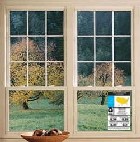I will be the first one to admit, our attic is finished. I had no control over that. The build out and remodel all took place 50 years ago. Does it make it better that we have a metal roof? When I first started saying PACK YOUR ATTIC with all the insulation you can get your hands on. Everyone said, “How can you say that. There is no payback. There is no room. What if you change your mind” That was of course in an R10 or an R13 world. Then everything changed. Guess what it will change again.
That is because we have all been raised in a “pay as you go” energy system. Have been for generations. But if you think of a world where you pay your energy costs “UP FRONT”. Then you quit worrying about Paybacks and “is it worth it”? You start thinking in terms of how much do I need.
Again for the entire class: You can never lose money by CONSERVING energy.
http://en.wikipedia.org/wiki/Superinsulation
Superinsulation is an approach to building design, construction, and retrofitting. A superinsulated house is intended to be heated predominantly by intrinsic heat sources (waste heat generated by appliances and the body heat of the occupants) with very small amounts of backup heat. This has been demonstrated to work in very cold climates but requires close attention to construction details in addition to the insulation.
Superinsulation is one of the ancestors of the passive house approach. A related approach to efficient building design is zero energy building.
There is no set definition of superinsulation, but superinsulated buildings typically include:
- Very thick insulation (typically R40 walls and R60 roof)
- Detailed insulation where walls meet roofs, foundations, and other walls
- Airtight construction, especially around doors and windows
- a heat recovery ventilator to provide fresh air
- No large windows facing any particular direction
- No conventional heating system, just a small backup heater
Nisson & Dutt (1985) suggest that a house might be described as “superinsulated” if the cost of space heating is lower than the cost of water heating.
:}
That last is important because what if you are using free solar. Then your costs are both zero. So one of them has to be a negative number…haha
http://www.builditsolar.com/Projects/SolarHomes/constructionps.htm
:}
On a more serious note, everyone agrees that the standard currently is good for NEW Construction…I say it is good enough for old as well:
http://www.residentialarchitect.com/industry-news.asp?sectionID=275&articleID=886806
massachusetts pilot project explores super insulation for old houses
new construction could also benefit from techniques.
Publication date: February 24, 2009
By Nigel F. Maynard
Alex Cheimets and Cynthia Page live in a duplex that used to consume about 1,400 gallons of heating oil a year. But now their building is one of the most energy-efficient in its Arlington, Mass., neighborhood, thanks to a pilot project that retrofitted the structure with almost $100,000 worth of insulation and other products to increase energy efficiency and lower utility costs.
The so-called Massachusetts Super Insulation Project seeks to determine the benefits and cost-effectiveness of retrofitting old energy-wasting houses with insulation upgrades in key areas. Though the cost for the upgrades in the home were substantial, some of the techniques used—among them proper air-sealing and adequate moisture barriers—are easily applied to new construction at a relatively low cost.
Massachusetts officials are keenly interested in the results of the project, because it dovetails nicely with the state’s efforts to become more energy-efficient. “Our governor, the state House and Senate, and the executive branch are aware that the nation’s energy strategy is not acceptable, and a big part of it is the existing housing stock,” says Philip Giudice, commissioner of the Massachusetts Department of Energy Resources (DER).
“Nationally, buildings account for 40 percent of all energy consumption, and one-third of all greenhouse gas emissions,” says Energy and Environmental Affairs Secretary Ian Bowles, who chairs Massachusetts Gov. Deval Patrick’s Zero Net Energy Buildings Task Force. “This superinsulation project in Arlington promises to be a model for the type of innovation in the building industry that the Patrick Administration hopes will soon be widespread across Massachusetts.”
Read more articles related to:
More articles from the headlines section
:}






















